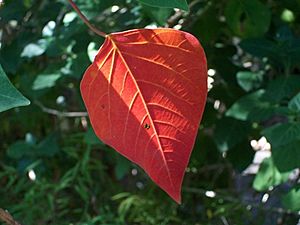Bleeding heart facts for kids
Quick facts for kids Bleeding heart |
|
|---|---|
 |
|
| Bleeding heart – senescent leaf | |
| Conservation status | |
| Scientific classification | |
| Genus: |
Homalanthus
|
| Species: |
populifolius
|
| Synonyms | |
|
|
The Bleeding Heart (Homalanthus populifolius) is a unique plant found in Australian rainforests. It's also called the native poplar or Queensland poplar. This plant belongs to the Euphorbiaceae family. You often see it growing in areas where the rainforest has been disturbed. This could be after a storm or logging.
People who help rainforests grow back really like the Bleeding Heart. It grows very quickly. This makes it a great "pioneer species." A pioneer species is one of the first plants to grow in a damaged area. It helps other plants and animals return.
Contents
Where the Bleeding Heart Grows
The Bleeding Heart plant grows along the coast of New South Wales and Victoria. Its range stretches north into Coen, Queensland in the tropics.
It is also naturally found on Lord Howe Island and Norfolk Island. You can find it in Papua New Guinea and the Solomon Islands too. People have planted it in many other places around the world.
This plant is also special because it's a host plant for Australia's biggest moth. This moth is called the Hercules moth (Coscinocera hercules).
What the Bleeding Heart Looks Like
The Bleeding Heart is a small tree or a shrub. It can grow up to 8 meters (about 26 feet) tall. Its trunk can be up to 15 centimeters (about 6 inches) wide.
The trunk is usually round. It has grayish-brown bark that is mostly smooth. But it might have some small bumps. Its branches look thick and can be reddish or green.
The leaves are shaped like triangles. They do not have jagged edges. They grow alternately along the stem. Each leaf is about 5 to 15 centimeters (2 to 6 inches) long. They look a lot like the leaves of a poplar tree. This is why its scientific name includes populifolius. The most interesting thing about the leaves is their color. When they get old, they turn bright red. This is why it's called the "Bleeding Heart."
Its Flowers and Fruit
The flowers of the Bleeding Heart are yellow-green to red. They grow in long clusters called racemes. These clusters are usually 2 to 10 centimeters (about 1 to 4 inches) long. You can usually see the flowers from September to December.
The fruit ripens from December to March. It is a two-lobed capsule. Inside, it has an oily yellow covering around the seeds called an aril. The seeds can sprout quickly if they get warm sunlight. However, like many pioneer plants, the seeds can stay dormant for a long time. This means they can wait to sprout until conditions are just right.
Many different birds enjoy eating the fruit of the Bleeding Heart. These include the brown cuckoo dove, the silvereye, and Lewin's honeyeater.
Why It's Important
The Bleeding Heart is a pretty plant. Its small size and bright red leaves make it a nice choice for gardens.
However, because it's a pioneer species, it can also spread easily. It can become an invasive species in new areas. This means it can grow too much and take over. It can sometimes harm the local plants. This has happened in southern Africa, Hawaii, and New Zealand.
Images for kids





